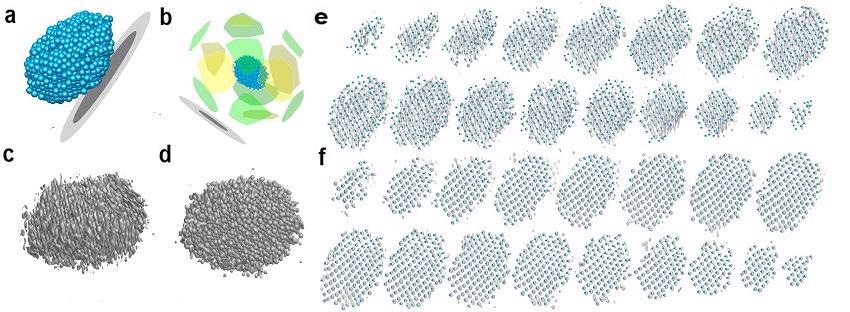May 13 2021
Atoms are known to be the fundamental building blocks for all kinds of materials. To customize functional characteristics, it is crucial to precisely establish their atomic structures.
 A. Overall atomic structure of a Pt nanoparticle determined in this study, with SiN substrate represented as black and gray disks. B. Identified facet structure of the Pt nanoparticle, showing all facets. C, D. Iso-surfaces of reconstructed 3D density from the electron tomography, before (c) and after (d) the deep-learning-based augmentation, respectively. E, F. Tomographic reconstruction volume intensity and traced atom positions. Each slice represents an atomic layer, and the blue dots indicate the traced 3D atomic positions before (e) and after (f) the deep-learning-based augmentation. The grayscale backgrounds are iso-surfaces of 3D density. Image Credit: The Korea Advanced Institute of Science and Technology.
A. Overall atomic structure of a Pt nanoparticle determined in this study, with SiN substrate represented as black and gray disks. B. Identified facet structure of the Pt nanoparticle, showing all facets. C, D. Iso-surfaces of reconstructed 3D density from the electron tomography, before (c) and after (d) the deep-learning-based augmentation, respectively. E, F. Tomographic reconstruction volume intensity and traced atom positions. Each slice represents an atomic layer, and the blue dots indicate the traced 3D atomic positions before (e) and after (f) the deep-learning-based augmentation. The grayscale backgrounds are iso-surfaces of 3D density. Image Credit: The Korea Advanced Institute of Science and Technology.
Scientists from The Korea Advanced Institute of Science and Technology (KAIST) have now observed the 3D atomic structure of a nanoparticle at the atomic level through neural network-assisted atomic electron tomography.
The researchers, headed by Professor Yongsoo Yang, used a platinum nanoparticle as a model system to demonstrate that an atomicity-based deep learning technique can consistently detect the 3D surface atomic structure with an accuracy of 15 picometers (just about one-third of a radius of a hydrogen atom). The strain, atomic displacement, and facet analysis demonstrated that the surface atomic structure and strain are associated with the shape of the nanoparticle as well as the particle-substrate interface.
Integrated with quantum mechanical calculations, like density functional theory, the potential to accurately detect surface atomic structures will act as a robust key for interpreting the oxidation effect and catalytic performance.
We solved the problem of determining the 3D surface atomic structure of nanomaterials in a reliable manner. It has been difficult to accurately measure the surface atomic structures due to the ‘missing wedge problem’ in electron tomography, which arises from geometrical limitations, allowing only part of a full tomographic angular range to be measured. We resolved the problem using a deep learning-based approach.
Yongsoo Yang, Professor, KAIST
The missing wedge problem leads to elongation and ringing artifacts—adversely impacting the precision of the atomic structure established from the tomogram—specifically for detecting the surface structures. This missing wedge problem has remained a major barrier to accurately determining the 3D surface atomic structures of nanomaterials.
The researchers employed atomic electron tomography (AET), which is essentially a very high-resolution CT scan meant for nanomaterials using transmission electron microscopes. AET helps determine the 3D atomic structures at the atomic level.
The main idea behind this deep learning-based approach is atomicity—the fact that all matter is composed of atoms. This means that true atomic resolution electron tomogram should only contain sharp 3D atomic potentials convolved with the electron beam profile.
Yongsoo Yang, Professor, KAIST
“A deep neural network can be trained using simulated tomograms that suffer from missing wedges as inputs, and the ground truth 3D atomic volumes as targets. The trained deep learning network effectively augments the imperfect tomograms and removes the artifacts resulting from the missing wedge problem,” added Professor Yang.
By using deep learning-based augmentation, the accuracy of 3D atomic structure can be improved by almost 70%. The precision of the identification of surface atoms was also considerably enhanced.
Structure-property associations of functional nanomaterials, particularly the ones that largely rely on the surface structures, like catalytic properties for fuel-cell applications, can currently be demonstrated at one of the most basic scales—the atomic scale.
We would like to fully map out the 3D atomic structure with higher precision and better elemental specificity. And not being limited to atomic structures, we aim to measure the physical, chemical, and functional properties of nanomaterials at the 3D atomic scale by further advancing electron tomography techniques.
Yongsoo Yang, Professor, KAIS
The study, published in the Nature Communications journal, was financially supported by the National Research Foundation of Korea and the KAIST Global Singularity Research M3I3 Project.
Journal Reference:
Lee, J., et al. (2021) Single-atom level determination of 3-dimensional surface atomic structure via neural network-assisted atomic electron tomography. Nature Communications.doi.org/10.1038/s41467-021-22204-1.
Source: https://www.kaist.ac.kr/en/